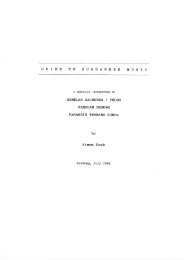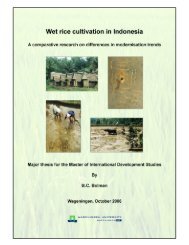The Students' Guide in Quantitative Analysis - Free Ebooks Library
The Students' Guide in Quantitative Analysis - Free Ebooks Library
The Students' Guide in Quantitative Analysis - Free Ebooks Library
You also want an ePaper? Increase the reach of your titles
YUMPU automatically turns print PDFs into web optimized ePapers that Google loves.
DISTILLATION OF PETROLEUM, i^t<br />
of about 500 c. c. capacity ; connect this with a Liebig's<br />
condenser, and arrange for distill<strong>in</strong>g <strong>in</strong> the usual manner.<br />
Through the tubulus of the retort <strong>in</strong>sert a thermometer.<br />
Provitk ten glass cyl<strong>in</strong>ders of 50 to 75<br />
c. c. <strong>in</strong> capacity,<br />
and mark each with a file, so as to show the volume occu-<br />
pied by 25 c. c. of liquid. <strong>The</strong>se cyl<strong>in</strong>ders are to serve as<br />
recipients of the distillate.<br />
Pour 250 c. c. crude petroleum <strong>in</strong>to the retort, and apply<br />
heat very gently at first, <strong>in</strong>creas<strong>in</strong>g gradually, and f<strong>in</strong>ally<br />
heat<strong>in</strong>g until the residue <strong>in</strong> the retort is coked. Collect<br />
25 c. c. of the distillate <strong>in</strong> the first cyl<strong>in</strong>der, and note the<br />
temperature <strong>in</strong>dicated by the thermometer <strong>in</strong> the retort<br />
collect the second 25 c c. <strong>in</strong> another recipient, note also<br />
temperature, and cont<strong>in</strong>ue <strong>in</strong> this manner, chang<strong>in</strong>g the<br />
recipient for every 2$ c c. until the whole liquid has dis-<br />
tilled over.<br />
B. — Exam<strong>in</strong>ation of the Distillates.<br />
Determ<strong>in</strong>e the sp. gr. of each distillate by float<strong>in</strong>g <strong>in</strong> it<br />
a small Baumd Hydrometer, note the color of each sam-<br />
ple, and determ<strong>in</strong>e its flash<strong>in</strong>g po<strong>in</strong>t by means of Taglia-<br />
bue's *' Open Tester," a figure and description of which are<br />
found on page 41, Vol. HI. of the "American Chemist."<br />
To test the flash<strong>in</strong>g po<strong>in</strong>t, proceed as follows : pour a<br />
small quantity of the sample to be e.Kam<strong>in</strong>ed <strong>in</strong>to the open<br />
cup, which is surrounded by a vessel of water. Light the<br />
lamp beneath and apply heat very gradually the tempera-<br />
;<br />
ture should not rise faster than two degrees a mmute.<br />
<strong>The</strong> thermometer bulb should dip beneath the surface of<br />
the oil. From time to time test the <strong>in</strong>flammable vapors<br />
which arise from the surface of the oil, us<strong>in</strong>g a small flame,<br />
flitt<strong>in</strong>g it quickly across the surface, and not<strong>in</strong>g simultane-<br />
ously the height of the thermometer at the moment of<br />
ignition. Record results with each distillate.<br />
;








